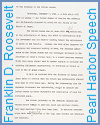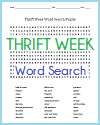Students are asked to complete this blank DIY infographic, listing the long- and short-term causes and effects of the Great Depression in United States history.
Click here to print (PDF). Answers will vary.
Short-Term Causes of the Great Depression (1929):
- Stock Market Crash: The immediate trigger was the Wall Street Crash of 1929, often referred to as "Black Tuesday." On October 29, 1929, the stock market experienced a sudden and catastrophic collapse, wiping out vast amounts of wealth.
- Bank Failures: The stock market crash caused a run on banks, leading to widespread bank failures. People rushed to withdraw their savings, but many banks were unable to meet these demands, further eroding confidence in the financial system.
- Reduction in Consumer Spending: The financial panic led to a significant reduction in consumer spending. People were hesitant to make purchases, causing a decline in demand for goods and services.
- Reduction in Business Investment: The uncertainty caused by the stock market crash and economic downturn led businesses to cut back on investments, expansion plans, and hiring.
Long-Term Causes of the Great Depression:
- Economic Imbalances: The prosperity of the 1920s was built on a foundation of economic imbalances. Income inequality was widespread, with most of the wealth concentrated in the hands of a few. This inequality hindered broad-based economic growth.
- Overproduction and Underconsumption: American industries had become incredibly efficient, leading to overproduction of goods. However, the wages of workers did not increase at the same rate, resulting in a gap between what was produced and what people could afford to buy.
- Agricultural Crisis: The agricultural sector faced a crisis throughout the 1920s. Falling crop prices, a lack of diversification, and the burden of debt placed many farmers in dire economic straits.
- Global Economic Factors: The world economy was interconnected, and the economic difficulties of other countries also played a role. The First World War had left Europe in economic disarray, and the U.S. was a major creditor to these struggling nations. When they couldn't repay their debts, it had a ripple effect on the American economy.
Effects of the Great Depression:
- Mass Unemployment: The most visible and devastating effect was mass unemployment. By 1933, an estimated 25% of the U.S. workforce was jobless. Families across the nation struggled to make ends meet.
- Bank Failures: Thousands of banks collapsed during the early years of the Great Depression, wiping out people's savings and eroding trust in the banking system.
- Hunger and Poverty: Poverty and homelessness were rampant. Soup kitchens and breadlines became a common sight as people sought food and shelter.
- Social and Political Consequences: The suffering and discontent of the era contributed to social and political changes. It gave rise to social and labor movements, like the labor strikes and the New Deal policies of President Franklin D. Roosevelt.
- Rise of the New Deal: President Franklin D. Roosevelt's New Deal programs aimed to alleviate the suffering and stimulate economic recovery. They included measures like public works projects, financial reforms, and social safety nets.
- Changes in Economic Policies: The Great Depression led to a reevaluation of economic policies. Financial regulations were introduced to prevent future economic crises, and social safety nets like Social Security were established.
- Impact on Global Economy: The Great Depression had a global impact. Trade declined, countries faced economic hardships, and it contributed to the political climate that led to World War II.
The Great Depression was a defining moment in American history, leading to significant changes in economic policies and social safety nets. It highlighted the need for better regulation and the role of the government in managing the economy during times of crisis.
|













